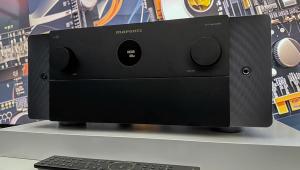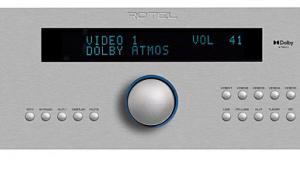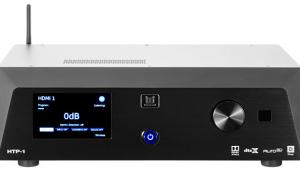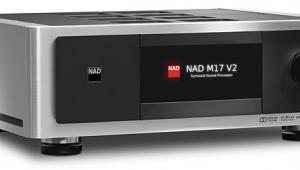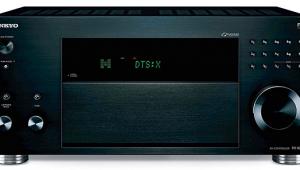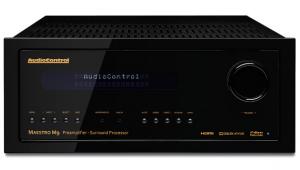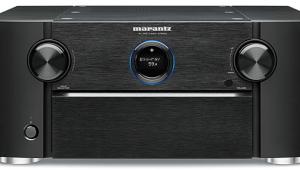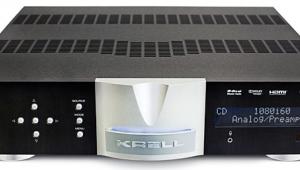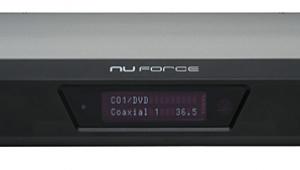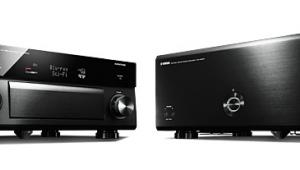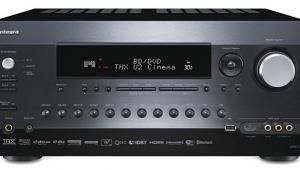Marantz AV7005 Surround Processor and MM7055 Amplifier Page 3
In terms of ergonomic implementation—user friendliness, ease of use, avoidance of “Help! I can’t get any sound!” syndrome—Marantz has done a superb job. The AV7005’s front-panel design, the onscreen GUI, and the learning remote control add up to an enjoyable A/V experience. Setting up and learning how to use the AV7005 isn’t difficult. Once you’ve learned it, you’re not likely to forget or find yourself reaching for the manual to accomplish infrequently accessed features. Other than the lack of a THX blessng and Audyssey’s latest auto calibration and EQ iteration, the AV7005’s feature set is unusually complete, particularly considering its relatively low price.
That Leaves the Sound
Over the past year, I’ve had the opportunity to review two finesounding surround processors: the $4,000 Cary Cinema 11a (Home Theater, May 2010) and the $2,199 Rotel RSP-1570 (November 2010). On the basis of pure sonic performance, I can confidently say that the Cary was the most accomplished-sounding front-end piece I’ve had in my system. It’s also the most expensive and lacks video-processing capabilities.
The Rotel was a sweet-sounding, sonically accomplished piece that was and is easy to recommend. Since I don’t have it in house, I can’t offer a meaningful and reliable sonic comparison, but I’d say the Marantz and the Rotel are in the same high-echelon sonic league.
Marantz uses off-the-shelf HDAM analog output modules. However, since both the shelves and the excellent-sounding and -performing modules belong to Marantz, that puts it at an advantage. I’ve reviewed more Marantz gear over the years than I can remember, and all of it has used variations on these modules—and all of it has sounded superb.
Not surprisingly, the AV7005 shares the same warm, transparent sound found in other Marantz gear I’ve reviewed. It’s free of hollow-metallic afternotes, edginess, brightness, and grit. The bottom end was nimble, well controlled, and well extended. The mids sounded rich, and the top end was reasonably airy and expansive. The AV7005 didn’t have the Cary’s iron grip on the bottom or shimmering precision on top, nor the Cary’s stunning immediacy or explosive dynamic impact. Still, it wasn’t far off the mark. The Marantz’s transient attack was decisive, its sustain was long enough to produce warm, extended fills, and the decay produced satisfying delicacy. Bill Evans’ classic Waltz For Debby live at the Village Vanguard on two-channel SACD let me know that.
The AV7005’s deviation from neutrality veers slightly in the direction of pleasing warmth and a subtle softness. I’ll take that every time over the big chill or hollowed-out sound that less accomplished electronics produce.
Beck’s sublime Sea Change SACD reiterated in 5.1-channel mode the AV7005’s warmth, transparency, and freedom from additive artifacts. Most impressive was the AV7005’s overall rhythmic coherence. When everything hangs together, guess what? You can relax into the music instead of fighting to make sense of it. I’m not sure there are measurements to reflect this, but that doesn’t mean you won’t know it when you hear it. Organizational skills are one of the first things people notice when they’re exposed to really fine audio for the first time. “I can hear each instrument separately, including some I never knew were there,” is how they usually put it.
I drove the Marantz’s phono preamp with a Shure M97xE cartridge fitted to an Ariston Icon turntable playing Mobile Fidelity’s superb 180g vinyl edition of Beck’s Sea Change mastered from the original analog tapes. It produced rich, warm, satisfying three-dimensional sound that was better than an afterthought from two speakers.
Even the three-position M-DAX compressed audio restoration circuit impressed me. For some reason, it only functions with Audyssey implemented, but it definitely made Internet radio far more listenable. It improved the perceived high-frequency response, reduced hardness and glare, and produced richer bass minus the usual processing artifacts that such circuits often impose.
I switched to cinema surround sound and watched the charming (500) Days of Summer. This chick flick stars the now grown-up child star of Third Rock from the Sun Joseph Gordon-Levitt and the moon-faced alt-rock beauty Zooey Deschanel. You’ll score points with your significant other and enjoy this smartly drawn, off-kilter romantic comedy that ends happily but not ever after.
A lot of movie sound is dialogue, and I paid attention to low-level dialogue intelligibility and timbral honesty. I tortured my wife by switching Audyssey on and off repeatedly. We agreed that the sound was more natural and less congested with Audyssey on. It produced dialogue that was far easier to understand, particularly at low SPLs. During the months that the AV7005 remained in my system, my center channel’s output was noticeably smoother than it is through my reference Integra DHC-9.9. With both movies and television programming, it was more transparent and less obviously “there.” That as much as anything sold me on the AV7005.

